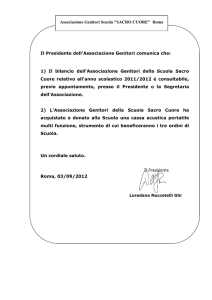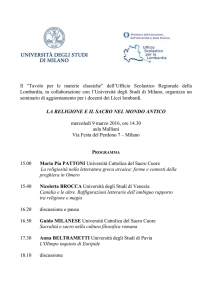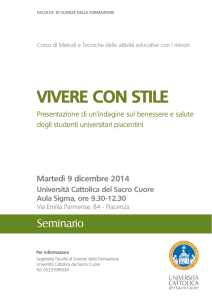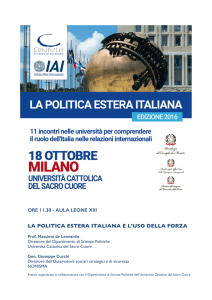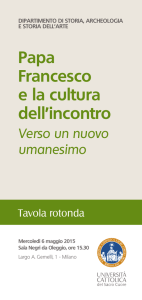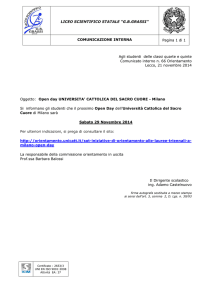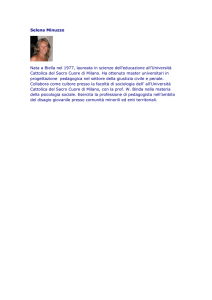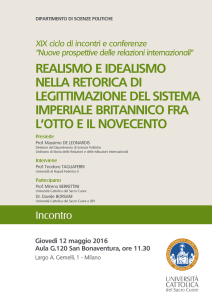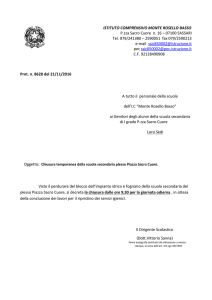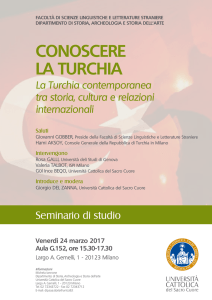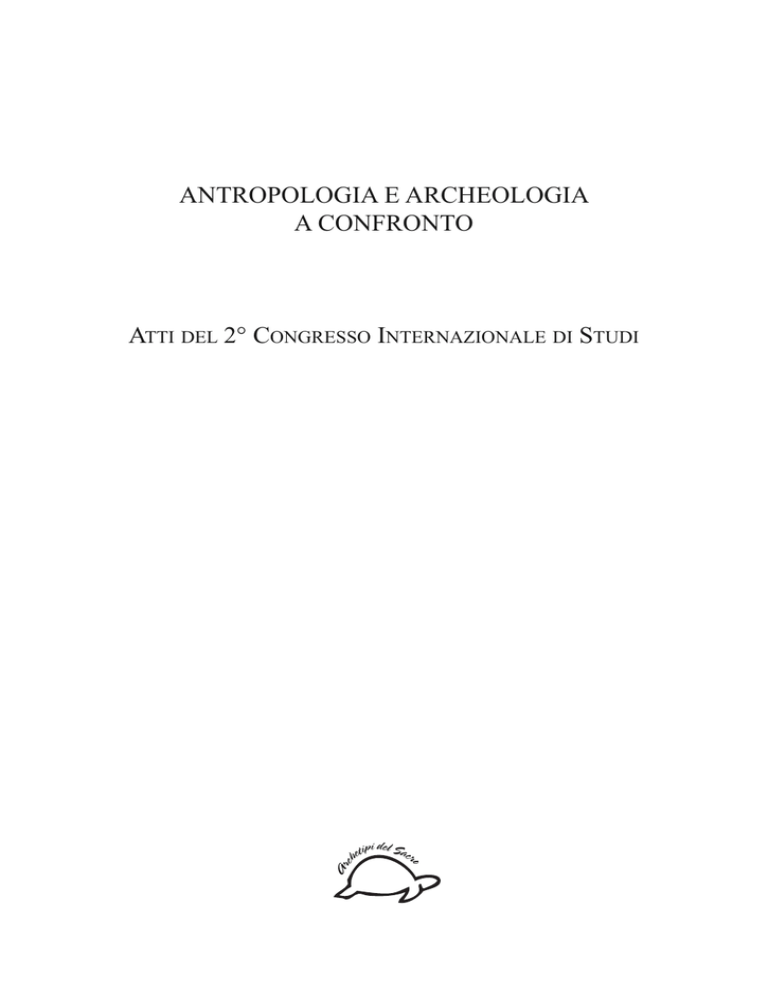
ANTROPOLOGIA E ARCHEOLOGIA
A CONFRONTO
ATTI DEL 2° CONGRESSO INTERNAZIONALE DI STUDI
Ar
ch
i del
etip Sacro
ANTROPOLOGIA E ARCHEOLOGIA A CONFRONTO
Ideazione e Progetto Scientifico
VALENTINO NIZZO
Direzione Editoriale
SIMONA SANCHIRICO
ANTROPOLOGIA E ARCHEOLOGIA
A CONFRONTO:
RAPPRESENTAZIONI E PRATICHE
DEL SACRO
Atti dell’Incontro Internazionale di studi
ROMA, MUSEO NAZIONALE PREISTORICO ETNOGRAFICO “LUIGI PIGORINI”
20-21 MAGGIO 2011
A cura di
VALENTINO NIZZO
LUIGI LA ROCCA
E.S.S.
EDITORIAL
SERVICE
SYSTEM S.r.l.
ROMA 2012
5
ANTROPOLOGIA E ARCHEOLOGIA A CONFRONTO:
RAPPRESENTAZIONI E PRATICHE DEL SACRO
Atti dell’Incontro Internazionale di Studi
Proprietà riservata-All Rights Reserved
© COPYRIGHT 2012
Progetto Grafico
System Graphic Srl
Tutti i diritti riservati. Nessuna parte di questo libro può essere riprodotta o trasmessa in qualsiasi forma o con qualsiasi mezzo elettronico, meccanico o altro, senza l’autorizzazione scritta
dei proprietari dei diritti e dell’Editore.
All rights reserved. No part of this publication may be reproduced, stored in a retrieval system,
or transmitted in any form or by any means, electronic, mechanical, photocopying, recording
or otherwise, without the prior permission of the publishers.
IN COPERTINA:
Fotomontaggio: Apoxyomenos, Museo di Zagabria; Maschera Azteca a mosaico,
Museo Preistorico Etnografico “L. Pigorini” Roma; Scheletro umano; Porzione di
volto: gentile concessione Loris Del Viva. Ideazione ed elaborazione grafica: VALENTINO NIZZO con la collaborazione di GIANFRANCO CALANDRA
PROGETTO SCIENTIFICO:
Valentino Nizzo (Soprintendenza per i Beni Archeologici dell’Emilia Romagna)
Con la collaborazione di:
Soprintendenza al Museo Nazionale Preistorico Etnografico “Luigi Pigorini”;
Elisa Cella (“Sapienza” - Università di Roma); Gianluca Melandri (Università degli
Studi di Milano)
CURATELA DEL CONVEGNO:
Luigi La Rocca (Soprintendenza al Museo Nazionale Preistorico Etnografico “Luigi Pigorini”); Valentino Nizzo (Soprintendenza per i Beni Archeologici dell’Emilia Romagna)
COORDINAMENTO ORGANIZZATIVO E SEGRETERIA:
Valentino Nizzo, Elisa Cella, Gianluca Melandri, Simona Sanchirico, Laura Pasquali, Ediarché-Editoria per l’Archeologia Srl.
6
CASA EDITRICE:
E.S.S. Editorial Service System srl
Via di Torre Santa Anastasia 61-00134 Roma
Tel 06.710561 Fax 06.71056230
[email protected] www.editorial.it
DIRETTORE EDITORIALE:
Simona Sanchirico
REDAZIONE:
Simona Sanchirico, Valentino Nizzo, Elisa Cella, Gianluca Melandri
COLLANA:
Antropologia e Archeologia a confronto 2
DIRETTORE DI COLLANA:
Valentino Nizzo
Finito di stampare nel mese di giugno 2012
dalla tipografia System Graphic Srl
Via di Torre Santa Anastasia 61-00134 Roma
Tel 06.710561 Fax 06.71056230
[email protected] www.sysgraph.com
SOSTEGNO LOGISTICO:
System Graphic Srl - Tipolitografia Stampa Digitale
Ediarché - Editoria per l’Archeologia Srl
Via di Torre Santa Anastasia 61-00134 Roma
Tel 06.710561 Fax 06.71056230
www.ediarche.it [email protected]
di Luciano Pasquali
Antropologia e archeologia a confronto: Rappresentazioni e pratiche del Sacro, Atti
del 2° Incontro Internazionale di Studi [Atti del Congresso tenutosi a Roma, Museo
Preistorico Etnografico “Luigi Pigorini”, il 20-21 Maggio 2011] / a cura di Valentino
Nizzo, Luigi La Rocca. Roma: E.S.S. Editorial Service System, 2012, pp. 902.
ISBN 978-88-8444-106-5
CDD D.930.1
1. Archeologia – Antropologia Culturale – Storia delle Religioni – Atti di Congressi
2. Sacro – Atti di Congressi
I. Valentino Nizzo, Luigi La Rocca
7
INDICE
LUIGI LA ROCCA, VALENTINO NIZZO, Premessa................................................p.
Ringraziamenti.................................................................................................p.
Programma del convegno ................................................................................p.
Abbreviazioni e norme bibliografiche .............................................................p.
INTRODUZIONE DEI LAVORI
VALENTINO NIZZO, Ripetere trasformandosi ....................................................p.
MARIO TORELLI, Riflessioni a margine della lettura di: Dalla nascita alla
morte: antropologia e archeologia a confronto...............................................p.
13
18
21
25
29
63
I SESSIONE. I LUOGHI DEL SACRO
MASSIMO OSANNA, Luoghi del Sacro in età arcaica presso le genti indigene
di Puglia e Basilicata..........................................................................................p. 71
GIANLUCA TAGLIAMONTE, I luoghi del Sacro nel Sannio preromano ...............p. 97
ENRICO COMBA, Tra l’erba e sotto le stelle: luoghi del sacro tra gli
Indiani del Nord America ................................................................................p. 109
ANNA MARIA GLORIA CAPOMACCHIA, I luoghi degli eroi .................................p. 125
II SESSIONE. I TEMPI DEL SACRO
ALESSANDRO GUIDI, I tempi del sacro nel Lazio protostorico..........................p.
MASSIMILIANO DI FAZIO, Tempo del sacerdote, tempo del cittadino.
Sacro e memoria culturale presso gli Etruschi.................................................p.
MANUELA MARI, La morte, il tempo, la memoria. Funerali pubblici e
calendario civico nella Grecia antica ...............................................................p.
ILEANA CHIRASSI COLOMBO, Riflessioni sul “sacro” tra phainomenon
e genomenon ....................................................................................................p.
137
147
167
189
DISCUSSIONE I E II SESSIONE
Moderatori: PIERO BARTOLONI, MARIANO PAVANELLO.
Interventi di: GIOVANNI CASADIO, FILIPPO DELPINO, LUCIANA DRAGO,
VITO LATTANZI, VALENTINO NIZZO, MARIO TORELLI ........................................p. 203
III SESSIONE. GLI SCOPI E I GESTI DEL SACRO
PIERO BARTOLONI, Appunti sul tofet..................................................................p. 215
IDA OGGIANO, Scopi e modalità delle azioni rituali femminili nell’area
8
siro-palestinese del I millennio a.C. Il contributo dell’archeologia.....................p.
MATTEO D’ACUNTO, I templi a focolare centrale cretesi alto-arcaici e
arcaici: rituali sacrificali e simbolismo politico..................................................p.
MARIA JOSÈ STRAZZULLA, Gesti e parole nei riti della vittoria in età romana.....p.
ALESSANDRA CIATTINI, Tra madonne e Cemí. Relazioni tra storia,
archeologia e antropologia nel Caribe ...............................................................p.
PINO SCHIRRIPA, Il corpo altare. Alcune riflessioni sulle antropologie
della possessione...............................................................................................p.
MASSIMILIANO A. POLICHETTI, Presupposti metafisici possibili nella
scarsità di evidenze archeologiche e storico-artistiche afferenti alla
ritualità vedico-brahmanica...............................................................................p.
223
251
263
279
293
305
DISCUSSIONE III SESSIONE
Moderatori: PAOLO XELLA, VITO LATTANZI.
Interventi di: PIERO BARTOLONI, ILEANA CHIRASSI COLOMBO,
ALESSANDRA CIATTINI, FRANÇOISE-HÉLÈNE MASSA PAIRAULT,
PINO SCHIRRIPA, MARIA JOSÉ STRAZZULLA .......................................................p. 309
IV SESSIONE. GLI OPERATORI DEL SACRO
MARINA PIRANOMONTE, Maghi professionisti alla fontana di Anna Perenna
(riassunto) .........................................................................................................p. 323
SERGIO BOTTA, Discorso accademico, turismo mistico e reazione indigena:
lo sciamanismo in Mesoamerica tra antropologia, storia e archeologia ..................p. 325
MARIANO PAVANELLO, MATTEO ARIA, Mediatori del sacro e del politico tra
memoria e postmodernità ...................................................................................p. 339
DISCUSSIONE IV SESSIONE
Moderatori: MARCELLO MASSENZIO, GIOVANNI COLONNA.
Interventi di: ANNA MARIA BIETTI SESTIERI, SERGIO BOTTA,
FILIPPO DELPINO, MARINO GIORGETTI, VALENTINO NIZZO,
MARIANO PAVANELLO, MARINA PIRANOMONTE, MARIO TORELLI ......................p. 367
V SESSIONE. LE IMMAGINI DEL SACRO
LUCA CERCHIAI, MAURO MENICHETTI, Sacro e cultura visuale ........................p. 379
MASSIMO CULTRARO, Quis deus? Su alcune rappresentazioni di carattere
cultuale nella Sicilia dell’età del Ferro........................................................................p. 387
ELVIRA STEFANIA TIBERINI, Mami Wata: arte e agency...............................................p. 401
DISCUSSIONE V SESSIONE
Moderatori: GIOVANNI COLONNA, VITO LATTANZI.
Interventi di: ANNA MARIA BIETTI SESTIERI, LUCA CERCHIAI,
MASSIMO CULTRARO, IDA OGGIANO, MARIA JOSÈ STRAZZULLA,
ELVIRA STEFANIA TIBERINI ...............................................................................p. 419
9
VI SESSIONE. GLI OGGETTI DEL SACRO
MARIA TOMMASA GRANESE, “Dare un senso alle cose”.
La funzione degli oggetti nei contesti sacri: l’esempio del santuario
sul Timpone Motta di Francavilla Marittima (CS) ..............................................p.
VINCENZO BELLELLI, Vei: nome, competenze e particolarità cultuali
di una divinità etrusca ......................................................................................p.
ALESSANDRA CARDELLI, Divinazione a Porto Novo. L’armamentario
del sacerdote del Fa .........................................................................................p.
STEFANO ALLOVIO, L’uso di oggetti nei rituali iniziatici e le forme
dell’immortalità ...............................................................................................p.
431
455
479
491
DISCUSSIONE VI SESSIONE
Moderatori: LUIGI LA ROCCA, VINCENZO PADIGLIONE.
Interventi di: STEFANO ALLOVIO, VINCENZO BELLELLI, ILEANA
CHIRASSI COLOMBO, MARIA TOMMASA GRANESE, MARIO TORELLI ..................p. 503
DISCUSSIONE GENERALE
Moderatori: MARIO TORELLI, ILEANA CHIRASSI COLOMBO.
Interventi di: STEFANO ALLOVIO, VITO LATTANZI, VALENTINO NIZZO,
IDA OGGIANO ...................................................................................................p. 513
CONCLUSIONI
MARIO TORELLI, Riflessioni conclusive ..........................................................p. 523
SESSIONE POSTER (A CURA DI ELISA CELLA E GIANLUCA MELANDRI)
ELISA CELLA, GIANLUCA MELANDRI, La sezione poster e il forum on-line:
un’occasione di verifica delle potenzialità offerte dai nuovi media alla
comunicazione scientifica................................................................................p.
I SESSIONE. I LUOGHI DEL SACRO
ANDREA BORELLA, La sacralità dell’ambiente domestico nella
cosmologia degli Amish...................................................................................p.
LUCIA BOTARELLI, FRANCO CAMBI, CARLO CASI, I culti
del Monte Amiata.............................................................................................p.
GIULIA CACCIATO, Il culto delle acque a Cirene ...............................................p.
DANIELA COSTANZO, Il tempio arcaico di Punta Alice (Cirò Marina, KR) ......p.
PATRIZIA FORTINI, Tullianum. Prime note sulla sua struttura
dai recenti scavi ...............................................................................................p.
NUCCIA NEGRONI CATACCHIO, MASSIMO CARDOSA, MARCO ROMEO PITONE,
Dalla grotta naturale al tempio, tra natura e artificio: forma ed essenza del
luogo sacro in Etruria durante l’età dei metalli................................................p.
SABRINA DEL PIANO, MICHELE PASTORE, Nota su un altare sacro nella
Gravina del Marchese a Crispiano-Montemesola (Taranto)............................p.
LIDIA PUDDU, La tomba di S’ena ‘e Sa Vacca a Olzai:
529
543
551
563
573
587
595
609
10
un originale esempio di sepoltura nuragica .....................................................p.
GIANFRANCA SALIS, Le rotonde con bacile d’età Nuragica.
Alcune considerazioni alla luce delle nuove scoperte nel villaggio
nuragico di Seleni (Lanusei, Prov. Ogliastra) ..................................................p.
ISIDORO TANTILLO, Alcune riflessioni sull’organizzazione spaziale dei
santuari demetriaci periferici delle poleis siceliote in età arcaica ...................p.
CLAUDIA TEMPESTA, Specus est nomine Corycius… La grotta di Tifone
e i santuari della Cilicia Tracheia orientale .....................................................p.
II SESSIONE. I TEMPI DEL SACRO
MARTA VILLA, Le pratiche del sacro nella ritualità invernale della
fertilità in una piccola comunità alpina: il case study di Stilfs in Vinschgau ..p.
III SESSIONE. GLI SCOPI E I GESTI DEL SACRO
ANGELA BELLIA, Da Bitalemi a Betlemme. Riti musicali e culti
femminili in Sicilia ..........................................................................................p.
TOMASO DI FRAIA: Il più antico esempio di incubatio: il sito rupestre
preistorico della parete Manzi (Civitaluparella, CH) ......................................p.
PIA GRASSIVARO GALLO, STEFANIA GAZZEA, Il Dikrì: le donne di
Merka (Somalia) pregano Allah per essere liberate dalla circoncisione
faraonica (infibulazione) .................................................................................p.
LUCA PISONI, UMBERTO TECCHIATI, VERA ZANONI, Tra il pozzo e
la soglia. Rites de rupture a Laion, Gimpele (BZ)? ........................................p.
ALEX VAILATI, L’azione del sogno nel sistema religioso Zulu.........................p.
IV SESSIONE. GLI OPERATORI DEL SACRO
ALESSANDRO BENCIVENGA, Le Paelignae anus di Orazio: maghe,
sacerdotesse o prostitute sacre? .......................................................................p.
SERENA BINDI, I Posseduti delle divinità della casa in Uttarkhand
(India del Nord). Negoziare la realtà della possessione: esperienze,
discorsi e pratiche ............................................................................................p.
SIMONA SANCHIRICO, I fondatori di colonie: il culto dell’ecista.......................p.
V SESSIONE. LE IMMAGINI DEL SACRO
GIUSEPPE GARBATI, Immagini e funzioni, supporti e contesti.
Qualche riflessione sull’uso delle raffigurazioni divine in ambito fenicio......p.
ILARIA TIRLONI, Immagini cultuali in Italia meridionale tra età del Bronzo
e prima età del Ferro ........................................................................................p.
ANNA TOZZI DI MARCO, Al Qarafa, ovvero la città dei morti del Cairo:
iconografica sacra nell’Islam popolare egiziano .............................................p.
VI SESSIONE. GLI OGGETTI DEL SACRO
LAURA CASTRIANNI, I dischi-pendenti d’avorio: significato e
funzione di una particolare classe di materiali.................................................p.
ELISA CELLA, Sacra facere pro populo romano: i materali dagli scavi
di Giacomo Boni dell’Aedes Vestae al Foro Romano .....................................p.
LUCIANA DRAGO TROCCOLI, Àncore litiche, Àncore in piombo e altri
“oggetti del sacro” in metallo dal santuario meridionale di Pyrgi...................p.
617
629
641
653
667
681
693
705
715
727
737
745
755
767
779
791
801
813
827
11
BARBARA FERLITO, La strumentazione del culto nel mondo greco ..................p.
GIANCARLO GERMANÀ, Offerte votive orientali in un contesto sacro
di età arcaica a Megara Hyblaea ......................................................................p.
MARTA PASCOLINI, Segni di passione: elementi di devozione popolare
negli alpeggi della Carnia ................................................................................p.
ELISA PEREGO, Resti umani come oggetti del sacro nel Veneto
preromano: osservazioni preliminari ...............................................................p.
841
851
863
873
ABSTRACTS E KEYWORDS
Relazioni ..........................................................................................................p. 883
Poster ...............................................................................................................p. 892
ABSTRACTS E KEYWORDS
RAPPRESENTAZIONI E PRATICHE DEL SACRO
883
RELAZIONI
M. OSANNA
Luoghi del sacro in età arcaica presso le genti indigene di Puglia e Basilicata
Despite the recent and increasing scholarly interest towards the morphology of the “sacred”
in the Italic world, scientific research is still adversely affected by the lacunose nature of current publications dealing with archaeological contexts. Furthermore, for the Archaic phase
another major problem is constituted by the difficulty de-codification of the archaeological
evidence. The marks which signal the sacred aspects of an almost unknown indigenous religiosity are in reality themselves very uncertain.
This paper addresses the problem of whether sanctuaries existed in the indigenous world of
Central-Northern Puglia and Basilicata. In particular, it questions whether there were temples
in the indigenous hinterland at all; by “temples” we mean buildings destined to house the
deity as an iconic image. An analysis of the archaeological evidence will demonstrate that
there were no temples, with the exception of the few cases illustrated in the paper. During the
Archaic Age communal ceremonial activities would have taken place in the palace of the
“leader” of the community. Finally, it is worth noting that the cult of the dead, strongly documented in the territory under examination, plays a role in social practices that in other contexts is usually played by religious cults.
Key-Words
Italici, Santuari, Templi, Palazzi, Rituali
GIANLUCA TAGLIAMONTE
I luoghi del sacro nel Sannio preromano
The evidence coming from the territory of the ancient Samnite tribes (Caudini, Pentri, Irpini,
Carricini, Frentani) shows that the presence of cult places and sanctuaries begins to have an
archaeological visibility as from the late-archaic age. This presentation is an attempt to stress
some of the “typological-structural” aspects relevant to the problem of the spreading of the
“sacred” within the Samnite context. In particular, this paper aims at understanding whether
the apparent absence, amomg the Samnite peoples, of cult-places dated before the late-archaic
age depends on a probem of archaeological visibility or if it may be considered a structural
phenomenon. On the basis of the dynamics of social change which interested ancient Samnium
during the late-archaic age, the second hypothesis seems to be more credible. The role that
some Samnite sanctuaries and cult-places might have had in the construction of an historical
and cultural memory is also emphasized.
Key-Words
Sanniti, luoghi di culto, santuari, memoria.
ABSTRACTS E KEYWORDS
884
ENRICO COMBA
Tra l’erba e sotto le stelle: luoghi del sacro tra gli indiani del Nord America
North American native peoples, like many others in different areas of the world, regard the
universe as constitute by both order and disorder. The world is animated by a life force or energy, mysterious and powerful, manifesting itself in the variety of objects and beings of the
“natural”, visible world, without identifying with it. This life force penetrates all through the
universe and produces the movement, growth and continuity of everything. Mankind has to
try to maintain a relative balance between the visible and invisible forces that constitute the
cosmos, allowing the development and increase of life forms through the performance of expressly designed sacred actions. These rituals and ceremonies contribute to the maintenance
of harmonic relations between humankind and the other components of the universe. Particularly important for ceremonial activities are specific landmarks, which play a determinant
role in the proper execution of ritual practices.
Sacred places are parts of the territory where an interface is possible between the terrestrial
dimension and the hidden spheres of the world above or the deep earth below. They are points
of conjunction, allowing a communication, a passage toward the invisible. The sacred mountains are places providing a connection with the sky people, the stars, but also where caves
open their mouths, giving access to the underground world, “portals” opening toward the unknown.
Key-Words
Indiani d’America, grandi pianure, montagne sacre, ricerca della visione, sacralità e mondo
naturale.
ANNA MARIA GLORIA CAPOMACCHIA
I luoghi degli eroi
The geographical context has an important role in the structure of the mythical tales. A peculiar
aspect of the representation of the Greek hero is his connection with the places. Heroes leave
their mark upon the places visited in the course of their existential journey. Their acts of foundation define the elements of landscape and give to the geographical places a proper settlement
in the historical time.
Key-Words
Eroi, Grecia, mito, geografia, percorsi
ALESSANDRO GUIDI
I tempi del sacro nel Lazio protostorico
In this article the A. tries to detect the different “time dimensions” (absolute, biological, calendric, cultural or mythical, urban) of the religious phenomena in pre- and protohistoric Laitum.
In this evolution, starting from the first, dubious data of the Paleolithic period, it’s possible to
see an ever growing integration of ritual activities in the social and economic structure, culminating with the birth of a true State religion in the early Iron Age.
RAPPRESENTAZIONI E PRATICHE DEL SACRO
885
Key-Words
Tempo, culto. rito, mito, religione
MASSIMILIANO DI FAZIO
Tempo del sacerdote, tempo del cittadino. Sacro e memoria culturale
presso gli Etruschi
This paper seeks to apply to Etruscan Culture concepts borrowed from the studies on Cultural
Memory. In particular, it shows how Cultural Memory can be useful to shed light on the use
of time by the Etruscans. As a matter of fact we have hints of a strong connection between
time and sacred, and of a local differentiation of calendars.
The paper also considers some cases of use of the past and history by the Etruscan aristocracy,
especially during the Hellenistic Age. The tools and concepts provided by Cultural Memory
Studies prove useful to a better understanding of these issues.
Key-Words
Etruschi, memoria culturale, tempo, calendario, storia.
MANUELA MARI
La morte, il tempo, la memoria. Funerali pubblici e calendario civico nella
Grecia antica
The paper analyzes some features of the manyfold relationship between public funerals and the ancient Greek conceptions about time (including in such a wide notion the reckoning of time, the actual
managing of local calendars, and the reshaping of local memories). Public funerals were usually
devoted to leading figures such as kings, generals, city founders and benefactors; the Athenian
democracy extended the use to the soldiers who fell in war. Public funerals of important individuals
(such as the colony founders and, possibly, the Spartan and Macedonian kings) were the starting
point for local cults whose focus was the grave of the hero, usually located in the very centre of the
city. The ruler cult of the Hellenistic period can only partly be explained as a development of the
tradition of the heroic cults paid to dead person and it is usually devoted, rather, to a living and powerful person, although in some cases (such as Alexander’s) both features are apparently present.
Key-Words
Grecia arcaica, classica ed ellenistica; riti funebri; culti eroici; cerimonie pubbliche e memorie locali.
ILEANA CHIRASSI COLOMBO
Riflessioni sul “sacro” tra phainomenon e genomenon
The paper explores the antinomy between history and phenomenology about the notion of the “sacred” (see Rudolph’s Otto well known “das Heilige”). Particularly the paper focuses on R. Pettazzoni
definition of the sacred as genomenon a (human) construction not a phainomenon, the appearance
of something which exists as such according to the meaning of Eliade neologism hierophany. At
the same time the paper points upon the different even opposite meanings the “sacred” can assume
passing from one linguistic-cultural level to another functioning as an important identity tool.
ABSTRACTS E KEYWORDS
886
Key-Words
Phainomenon, genomenon, ierofania, sacro, identità, Pettazzoni.
PIERO BARTOLONI
Appunti sul tofet
The problems concerning the Tofet, i.e. a name of biblical origin become a generic name for
a unique sanctuary of the Punic and Phoenician civilization, seemed now dormant, or, better,
enough shared within the world of studies, although there are two trends, the first one inclined
to accept the idea of human sacrifice of children, the second one to reject it. The problem at
the moment apparently remains unsolved.
Key-Words
Fenici, Cartaginesi, Sardegna, Tofet, Necropoli.
IDA OGGIANO
Scopi e modalità delle azioni rituali femminili nell’area siro-palestinese
del I millennio a.C. Il contributo dell’archeologia
After the evaluation of the euristic potential of archaeological artifacts in interpreting the “religious phenomenon”, we present some archaeological examples of rituals performed by
women, usually connected to birth, death, memories. The spatial dimension of rituals is indicated by stratigraphical data (as in Tell Jawa, and Tyre) and the morphology of artifacts (Israelitic horned altars). Protagonists, gestures and the tactile, visual and olfactory experiences
of rituals are evoked by images (Judean Pillar Figurines, Dea Tyria Gravida, Temple Boy)
and particular types of objects (perfume burners).
Key-Words
Archeologia del culto, area siro-palestinese, donna, infanzia, rituale
MATTEO D’ACUNTO
I templi a focolare centrale cretesi alto-arcaici e arcaici: rituali sacrificali
e simbolismo politico
This paper deals with the functions and socio-political meanings of the Geometric and early
Archaic central-hearth temples in Crete: the Delphinion (ca. end of the 8th cent. B.C.) and
the West acropolis temple in Dreros; the temple A in Prinias (ca. 650-640 B.C.); the temple B
in Kommos (800-600 B.C.). These temples show several differences in their plan and location
of the god and of the sacrificial structures. Their ritual focus is the central eschara – altar
which establishes an inner space for the civic sacrifice together with the outer open space.
The relationship between the sacrifice participants and the presence of the god – e.g. in the
Dreros Delphinion the well-known cult images of the Apollinian triad – implies a socio-political symbolism involving the members of an aristocratic city. The case of Kommos is made
different by the extra-urban function of the sanctuary, which focuses during phases B1-2 on
the “Phoenician” tripillar shrine.
RAPPRESENTAZIONI E PRATICHE DEL SACRO
887
Key-Words
Tempio, dio, cuore, sacrificio, animale, città, aristocrazia, scultura, pithos, vino.
MARIA JOSÉ STRAZZULLA
Gesti e parole nei riti della vittoria in età romana
This paper is dealing with the sacred rites which Romans used to perform during their wars.
First of all, a war, to be won, had to be iustum ac pium, i.e. it had to follow the rules of a
moral right and to be put under the protection of the gods: thus it was declared by special
priests, the Fetiales, and with since long time fixed formulas. Other rituals could follow during
wartime, such as vota, evocatio and devotio. With the evocatio the Roman commander invited
the gods living in the enemies country to leave it and to move to Rome, where they could find
a better worship. The devotio consisted in a terrible course which usually was struck against
the foe army; sometimes, in the case auspices before battle were bad, the commander could
devote himself (or another soldier) to death, in order to offer his own sacrifice in change of a
good outcome for Rome. Of course rituals were made of words and gestures and ancient
sources sometimes are reporting this kind of obscure, almost magical speeches, accompanied
by precise gestures, dictated by the pontifices.
The last part of the paper takes into account the traditional report about the conquest of Vei
by Furius Camillus and that one of Carthago by Scipio Aemilianus: in both cases a complete
set of rituals was put on. At the very end of the story, when the enemies city had already be
conquered, both Camillus and Scipio burst out into tears. However, this cannot be considered
an emotional experience. At the contrary the tears of the winner, often combined with the gesture of turning to the right, are part of a final rite, aiming to avoid the overturning of the present
great Fortune of Rome.
Key-Words
Fortuna, bellum iustum, evocatio, devotio, lacrime, giravolta rituale.
ALESSANDRA CIATTINI
Tra Madonne e Cemí. Relazioni tra storia, archeologia e antropologia nel Caribe
The article uses a multidisciplinary perspective to interpret particular religious and cultural
dynamics produced by the colonization and evangelization of the Caribbean region. In particular, the article focuses on the behaviour of the Taino in relation to images representing sacred figures belonging to the catholic tradition. The argument proceeds by delineating how
such figures are received and accepted, but also integrated in the Taino animistic worldview.
By developing this approach the author aims to revaluate the indigenous contribution in the
formation of the Caribbean cultural mosaic.
Key-Words
Cultura dei taíno, immagini religiose, incontro, scontro culturale, animismo.
PINO SCHIRRIPA
Il corpo altare. Alcune riflessioni sulle antropologie della possessione
The Author discusses, through some ethnographic examples, about spirit possession, focusing
on the body of the possessed person. The body is the material side of an immaterial relation.
ABSTRACTS E KEYWORDS
888
Through it spirit possession is visible and tangible to all the community. The Author stresses
as the body is the focus through which is possible to analise how spirit possession is the way
for producing and reproducing social relations, memories, powers and counter-hegemonic
discourses.
Key-Words
Africa, Italia meridionale, possessione spiritica, corpo, produzioni sociali.
MASSIMILIANO A. POLICHETTI
Presupposti metafisici possibili nella scarsità di evidenze archeologiche e
storico-artistiche afferenti alla ritualità vedico-brahmanica
The lack of material evidences quoted in the title of this communication, and the possibility
of the relationship between this lack of evidences and the theoretical-speculative assumptions
of Vedic liturgy, is one of the problematic issues present among specialists in the field of
Indian studies. This issue has been, among the others, recently brought to the attention of a
wider audience through the publication of the volume of Roberto Calasso L’Ardore (2010).
India is sometime correctly defined by specialists as a ‘living stratigraphy’, pointing out a
privileged context – and of course not just for anthropology – which allows the synchronous
observation of otherwise extremely distant phases of development of the human civilization.
In the case of the lack of evidences relating to the Vedic rituals, the component of climate has
certainly facilitated the degradation of the Indian subcontinent material cultural remains, and
particularly those related to a religion that has used little more than altars made by sun-dried
bricks. The Vedic sacrifice (yajna) is intended not so much, as perhaps we would expect, to
restore an order broken in a mythical time, but to be the foundation for the very order of this
world, being the generator of space and time through which it is built the unbroken texture of
reality. We are therefore facing a sacred liturgy not with a ‘cosmological meaning’, but considered to act as an ‘effective cosmogony’, the inexhaustible wellspring of being that doesn’t
need further evidences other from itself.
Key-Words
Subcontinente indiano, civiltà vedico brahmanica, ritualismo vedico, archeologia, filosofia
della religione.
MARINA PIRANOMONTE
Maghi professionisti alla fontana di Anna Perenna
SERGIO BOTTA
Discorso accademico, turismo mistico e reazione indigena: lo sciamanismo
in Mesoamerica tra antropologia, storia e archeologia
During the last decades, the use of the term “shamanism” as a central concept in the field of
Anthropology of Religion and Religious Studies passed through a profound methodological
redefinition. This academic statement is a demand that comes mainly from an ethnographical
perspective, especially from “local” contexts such as Siberian, Amazonian, and Mesoamerican
1
Cfr. nel testo [N.d.R.].
RAPPRESENTAZIONI E PRATICHE DEL SACRO
889
studies. The purpose of this paper is to observe the connections between academic debates,
mystical tourism and indigenous reactions in the construction of a public discourse within
Mesoamerican studies and in order to describe a specific function of shamanism in the manufacturing of religious difference in contemporary Western society.
Key-Words
Sciamanismo, Mesoamerica, religioni indigene, turismo mistico, rituali e sostanze allucinogene.
MARIANO PAVANELLO, MATTEO ARIA
Mediatori del sacro e del politico tra memoria e postmodernità
The authors aim at presenting a research on two different postcolonial fields, West Africa
(Akan area) and Oceania (French Polynesia), dealing with peculiar social agents who may be
labeled as passeurs culturels: the Akan traditional chiefs and the Polynesian rediscoverers of
traditions. These agents are constantly mediating between cultural memory and modernity,
as well as between the sacred and the politics. They are committed in shaping original cultural
forms shifting continually from modernity to tradition and vice versa. As co-protagonists of
multi-handed political, economic and heritage-making processes, they show ability in connecting different cultures and in shifting nimbly from a context to another, by crossing symbolic and semiotic borders which otherwise are not so permeable. Manipulating different
languages, the passeurs culturels are capable to mix up the discourse on the sacred and the
political rhetoric in a creative way, as well as to give an original sense to key-notions as “tradition” and “identity”, which thanks to their action gain new significance.
Key-Words
Africa, Akan, Nzema, Oceania, Polynesia, passeurs culturels, tradizione, modernità, postmodernità, sacro, politica.
LUCA CERCHIAI, MAURO MENICHETTI
Sacro e cultura visuale
The research is aimed to approach the topic of the representation of the sacred and religious
world according to the methods applied by the Visual Culture. As sample we took into consideration some aspects of the iconography of Dionysus and Kore as visible in the Campanian
black-figure pottery.
Key-Words
Sacro, Iconografia, Immaginario, Cultura Visuale, Ceramica campana a figure nere.
MASSIMO CULTRARO
Quis deus? Su alcune rappresentazioni di carattere cultuale nella Sicilia
dell’età del Ferro
The Late Bronze Age - Iron Age in Sicily, conventionally dated between about 900 BC and
the foundation of the first Greek settlements, is a period of radical changes of the socio-economic structures, as well as the ideological sphere. This paper aims to investigate the role
played by the religious sphere in the centralized and relatively complex ‘chiefdoms’, in the
ABSTRACTS E KEYWORDS
890
same time when the first human figurines and representations largely occur in the local iconographical repertoire. A two-handled amphora found in the indigenous sanctuary at Polizzello
(central Sicily) shows an intriguing scene with horsemen and warriors. The iconographic
analysis of the scene can shed light on ideologies and cults, focusing also on the close cultural
links between Sicily and the peninsula during the Late Bronze and Iron Ages.
Key-Words
Sicilia; età del Ferro; culti acquatici; simbologia celeste; toro; simbologia dello scudo.
STEFANIA TIBERINI
Mami Wata: arte e agency
The paper deals with two different anthropological perspectives on Mami Wata’s imagery and
cult. After a preliminary overview on Mami Wata’s history, cult and iconography and on the
related rituals and performances, the A. examines the different approaches adopted by J.H.
Drewal and by C. Gore and J. Nevadomsky. The latter argues that Mami Wata is not a panAfrican deity imported from Europe as Drewal suggests and that, on the contrary, she describes
independent traditions and diverse deities in different societies, insisting that Drewal’s perspective obscures their nuances and downplays the agency of the local ritual operators.
Key-Words
Mami Wata, Anthropology, Theories, Art, Agency.
MARIA TOMMASA GRANESE
“Dare un senso alle cose”. La funzione degli oggetti nei contesti sacri:
l’esempio del santuario sul Timpone Motta di Francavilla Marittima (CS)
The systematic reconsideration of the archaeological evidence also taking account of the function of objects has permitted. The reconstruction of ritual practices and cultic aspects in the
sanctuary of Francavilla Marittima, in the territory of the colony of Sybaris. The deity or
deities worshipped presided over rites of passage to adult life and stood as guarantor of the
civic order. This role is even more significant a site, where a Greek sanctuary constructed
onto an indigenous village stood as symbol of the Greek takeover of the area, but, also, must
have acted as an instrument of integration.
Key-Words
Territorio di Sibari, santuario, funzione reperti, rituale, culto.
VINCENZO BELLELLI
Vei: nome, competenze e particolarità cultuali di una divinità etrusca
This paper’s aim is providing a general overview on an Etruscan Goddess – Vei – who is far
to be known in detail despite her importance inside the Etruscan pantheon. Vei corresponds
indeed to Greek Demeter and Italic Ceres and is worshipped in several sites of southern
Etruria, and in particular Veii, Caere, Tarquinia, Vulci and Volsinii. The article develops results
of research by the Author undertaken on the site of Vigna Parrocchiale at Caere, and offers an
interpretation of the objects which are related to the cult of Vei, reexamining the contexts in
RAPPRESENTAZIONI E PRATICHE DEL SACRO
891
which they appear. In order to give a complete survey on the subject, the Author examines in
the end the problem of the name of the Goddess, which is similar to that of the Etruscan town
Veii.
Key-Words
Etruschi, Religione, Pantheon, Culto, Vei.
ALESSANDRA CARDELLI
Divinazione a Porto Novo. L’armamentario del sacerdote del Fa
An encounter with one of the bokonõ – i.e. priest and interpreter of Fa oracle - performing in
Porto Novo (Republic of Bénin, formerly colonial Dahomey) in 1998. Thanks to such a contact with museum’s people, Casimir’s first intent, in revealing secret ritual contents, was apparently to “make a book”. A short description of the ritual, it’s tools and implements, is given:
Fa divination system not being based on personal power of prophecy, but rather on an intricate
and subtle system of signs or geomantic figures (sixteen major signs and 256 derivative ones)
which makes the Corpus of an oral literary tradition.
Key-Words
Divinazione, Fa, Ifa, Afa, Africa.
STEFANO ALLOVIO
L’uso di oggetti nei rituali iniziatici e le forme dell’immortalità
The initiation rites into adulthood allow children to recognize themselves as real members of
a group and let participants to reflect on the very meaning of existence. One purpose of these
rites seems to be to redemptiom of individual existence from the inevitable death involving
the initiates into a dimension that goes beyond the vita brevis. In the essays we show how in
many ethnographic cases the use of specific ritual artifacts (masks, medicines) is fundamental
to obtain a “provisional immortality”.
Key-Words
Rituale, iniziazione, immortalità, maschere, medicine.
ABSTRACTS E KEYWORDS
892
SESSIONE POSTER
ELISA CELLA, GIANLUCA MELANDRI
La sezione Poster e il Forum on-line: un’occasione di verifica delle potenzialità offerte dai nuovi media alla comunicazione scientifica
For this meeting, we used an upgraded set of the tools we presented last year. The website
Ediarché still has a main role in the online publication of posters and in the Forum. Our Facebook profile was then used to launch the call for posters, creating strong networking action
within leading archeology/anthropology sites and blogs. Moreover, we added a video channel
on YouTube, dedicated to extracts from the two conference editions: statistics stress the good
reception of this new promotional tool. The online publication of posters is becoming for us
a trial field for a new way of communicating scientific content and can be an investigative
object itself.
Key-Words
Poster, Forum, Media, Antropologia, Archeologia.
ANDREA BORELLA
La sacralità dell’ambiente domestico nella cosmologia degli Amish
This paper is based on a long-term anthropological research “on the field,” conducted over
the last four years in an Old Order Amish community in Lancaster County, Pennsylvania. My
argument is that the most sacred place among the Amish is the house, or the farm. Indeed, the
religious services are held in the domestic context and a huge part of the life of the Amish is
strictly connected with the household. Moreover, I maintain that the Ordnung, the communitarian laws that rule the life of the Amish, compel the members to stay as close as possible to
the church, that is the community, in order to achieve a symbolic separation from the “evil
worldliness.”
Key-Words
Ambiente domestico, Amish, Cristianesimo, Ordnung, Stati Uniti d’America.
LUCIA BOTARELLI, FRANCO CAMBI, CARLO CASI
I culti del Monte Amiata
The Monte Amiata is characterized by several archaeological sites dealing with ancient cults.
During the Bronze Age chthonic worship were performed in Poggio La Sassaiola, while during
the Etruscan and early Roman Age the local cults can be referred to the natural resources of
the mountain and its geographical features and position: we know cults of healing and spring
waters, mountain cults and frontier cults. As for Abbadia San Salvatore, in particular, the worships of Iuppiter is turned into the Christian cult of Christ Pantocrator, who keeps to have the
same attributes: the lighting and the oak.
RAPPRESENTAZIONI E PRATICHE DEL SACRO
893
Key-Words
Monte Amiata, Culti, Età del Bronzo, Periodo etrusco, Età Romana.
GIULIA CACCIATO
Il culto delle acque a Cirene
The presence of interesting religious manifestations in the ancient Cyrene seems to be connected with the cult of water’s personifications (springs or rivers). This review of archaeological data and literary and epigraphic sources looks towards the interaction between religion
and natural world’s expressions.
Key-Words
Cirene, Ninfe, Fonti sacre, Culto delle acque, Terrazza della Myrtousa.
DANIELA COSTANZO
Il tempio arcaico di Punta Alice (Cirò Marina, KR)
This work examines the archaeological evidence relative to the Archaic temple of Apollon
Aleus, come to light in the Twenties near Punta Alice (Cirò Marina, KR). The most ancient
signs of frequentation date back to the 7th century B.C., but the temple was built on the 6th
century. Its architectonic features and votive offerings are peculiar to the Indigenous groups
settled in the area, whose cities (Chone, Makalla, Petelia) have been founded, according to
the myth, by Philoktetes, also considered the founder of the Apollonian cult at Punta Alice.
The hero was the most suitable figure to act as a link between Greeks and the native populations. The sanctuary of Apollon Aleus is finally examined in the light of its nature of frontier
between the chorai of Sybaris and Kroton and the Indigenous settlements, as a place of contact
and religious, political and social aggregation.
Key-Words
Apollo, Punta Alice, Tempio, Età arcaica, Filottete.
PATRIZIA FORTINI
Tullianum. Prime note sulla sua struttura dai recenti scavi
Recent excavations shows that Carcer-Tullianum is made of rooms on different layers, all
linked to the defensive system of the Capitoline Hill (“Mura Serviane”). The Tullianum became part of the whole complex after the Carcer front was made. It had an originally circular
pavement made of overlapping blocks (V a.C.), in which a squared hole reaching to the top
allowed water to come out from the subterranean spring. The rests of a votive deposit cut in
one of the pavement parpaings shows the original sacred nature of Tullianum.
Key-Words
Carcer, Tullianum, Foro Romano, Deposito votivo, Acqua.
ABSTRACTS E KEYWORDS
894
NUCCIA NEGRONI CATACCHIO, MASSIMO CARDOSA, MARCO ROMEO PITONE
Dalla grotta naturale al tempio, tra natura e artificio: forma ed essenza
del luogo sacro in Etruria durante l’età dei metalli
Some features seem to characterize a process of “artificialisation” and imitation of the natural
sacred place in Etruria during the age of metals, from the natural sacred place (water source,
mountains and caves for example) to the built one. In the Copper age, burial caves are created,
but sometimes hypogeic structures are intended for ritual practice (Corano, Fosso Conicchio
and Naviglione). During the Final Bronze Age we find the worship places into the settlement:
artificial hills (le Sparne di Poggio Buco) and caves (Sorgenti della Nova) that recover, at
least conceptually, the natural ones. In the Villanovian settlement, we foud the temple-houses,
similar to those for domestic use, and only in the Orientalizing Period, the real temple.
Key-Words
Preistoria e Protostoria, Strutture sacre naturali, Strutture sacre artificiali, Antropologia del
sacro.
SABRINA DEL PIANO, MICHELE PASTORE
Nota su un altare sacro nella Gravina del Marchese a Crispiano-Montemesola (Taranto)
During the surveying of the sapping valley “Gravina del Marchese” in the territory of Crispiano-Montemesola (Province of Taranto), a monolith lying at the end of the valley has been
studied and documented. The structure that still has no equal in other southern areas of Italy,
is compared with similar structures existing in central Italy.
Key-Words
Geo-archeologia, Altare sacro, Crispiano-Montemesola, Taranto.
LIDIA PUDDU
La tomba di S’ena ‘e Sa Vacca a Olzai: un originale esempio di sepoltura
nuragica
Spirituality in nuragic Sardinia is particularly expressed in the cult of the dead. This is shown
by the proliferation of megalithic tombs called tombs of giants, in which the community buried
their own dead, without distinction, and performed repetitive collective rituals. To the hundreds of known tombs of this kind, that of Ena ‘e Sa Vacca Olzai (Nu) should be added: the
archaeological excavation has provided a wealth of information about the structure of the
tombs of giants, and the practiced cults.
Key-Words
Funerario, Nuragico, Tomba, Olzai, Culto.
RAPPRESENTAZIONI E PRATICHE DEL SACRO
895
GIANFRANCA SALIS
Le rotonde con bacile d’età Nuragica. Alcune considerazioni alla luce delle
nuove scoperte nel villaggio nuragico di Seleni (Lanusei, Prov. Ogliastra)
In the nuragic village Genn’accili at the forest Seleni (Lanusei, prov. Ogliastra) investigations
by the Direction for Archeological Heritage revealed an interesting town and a round with a
bowl in use until at least the 7th century a. C. Some structural details make this round, which
broadens the distribution of type of paper in the central-eastern Sardinia, of particular interest
and provides the opportunity for a reinterpretation of the architectural and type of his sacred
function.
Key-Words
Rotonde con bacile, Culto dell’acqua, Età nuragica, Bacile, Età del Ferro.
ISIDORO TANTILLO
Alcune riflessioni sull’organizzazione spaziale dei santuari demetriaci periferici delle poleis siceliote in età arcaica
The analysis has identified some factors characterizing the demetriaci peripheral sanctuaries:
the preference of temples “oîkos”, which were functional to the needs of worship, as could be
construed as collection points for votive offerings and reproducing the underground places;
the “structural poverty”, revealing a concept of the “sacred”, referring to the sphere of underworld, which did not require a “solemn event” but rather a “private holding” to the ritual; the
essential organization of the tèmene, not lacking, however, to essential equipment to the practice of worship.
Key-Words
Demetra, Demetriaci, Suburbani, Santuari, Architettura, Spazio.
CLAUDIA TEMPESTA
Specus est nomine Corycius… La grotta di Tifone e i santuari della Cilicia
Tracheia orientale
The case of the Cilician cave known as Korykion Antron sheds light on the features that define
a sacred place. Located in the inland of the ancient Korykos, it consists of two deep chasms,
where the myth places Typhon’s dwelling as well as the setting of his struggle against Zeus.
The sanctuary was formed by three places of worship, consecrated to Hermes and Pan (at the
bottom of the chasm) and to Hermes (on its border) and Zeus Korykios (3 km away). The
sanctuary lived from Hellenistic to Roman times and then was converted into a Christian
place, preserving its sacred nature so far.
Key-Words
Cilicia, Caverne cultuali, Tifone, Zeus, Ermes.
896
ABSTRACTS E KEYWORDS
MARTA VILLA
Le pratiche del sacro nella ritualità invernale della fertilità in una piccola
comunità alpina: il case study di Stilfs in Vinschgau
In Provincia Autonoma of Bozen in the community of Stilfs in Vinschgau still has a regular
winter ritual revolving around the fertility, investing primarily young males as agents of the
rites and the whole community as a spectator. The rituals of the annual cycle are three (the
rite of Klosen, the rite of Pflugziehen and the rite of Scheibenschlagen) and take place from
December to February/March. They are all characterized by elements who insist around the
sphere of religious practice and do not require the active involvement of women, who are
only spectators, but around the request and to appease their fertility and that the earth revolves
around the annual ritual cycle.
Key-Words
Rituale, Maschera, Fertilità, Antropologia alpina, Sacro.
ANGELA BELLIA
Da Bitalemi a Betlemme. Riti musicali e culti femminili in Sicilia
Bitalemi is the name of a locality situated at the mouth of the river Gela. The site of Bitalemi
is known in archaeological literature as a sacred place for the chthonic deities. The findings
have amply documented that in the Greek sanctuary took place Thesmophoria rituals. Literary
sources do not explicitly refer to sound events in the holidays celebrated in honor of Demeter
in Sicily. Based on archaeological evidence, in particular the discovery of musical instruments
and of figurines of female players in the sicilian demetriac shrines, at the music could been
given a significant role.
Key-Words
Aulos, Tympana, Kithara, Kymbala, Suonatrice.
TOMASO DI FRAIA
Il più antico esempio di incubatio: il sito rupestre preistorico della parete
Manzi (Civitaluparella, CH)
The Parete Manzi can be interpreted as a real prehistoric cult place, for these features: 1) a
rock wall painted; 2) a large stone with engraved signs; 3) two crosses engraved on the wall,
in an area strongly smoothed; 4) the part of the stone close to the wall is also smoothed. The
stone then was used as a bed, in which a person lying down could touch just the portion of
wall with the engraved crosses. This context quite corresponds to the conditions we know for
the ritual called incubatio, that required the permanence on a rock bed to obtain some benefit
from some supernatural power.
Key-Words
Arte rupestre preistorica, Simboli, Letto in pietra, Luogo di culto, Incubatio.
RAPPRESENTAZIONI E PRATICHE DEL SACRO
897
PIA GRASSIVARO GALLO, STEFANIA GAZZEA
Il Dikrì: le donne di Merka (Somalia) pregano Allah per essere liberate
dalla circoncisione faraonica (infibulazione)
The women’s prayer has been included into the Pharaonic Circumcision/Infibulation Prevention Program prepared by Mana Sultan Abdurahman Ali Isse and has been regularly practised
every Friday in the bush of Lower Scebelle since 1977. Women pray in a circle, singing, dancing, listening to the ummulìso and to speeches of other testimonials, eating togheter. In such a
way they become the protagonists in this celebration day, in which they are all equally important and difficult problems are shared.
Key-Words
Circoncisione faraonica, Somalia, Prevenzione, Dikrì, Riti di possessione.
LUCA PISONI, UMBERTO TECCHIATI, VERA ZANONI
Tra il pozzo e la soglia. Rites de rupture a Laion, Gimpele (BZ)?
The 2000-2004 excavations, carried out in the long-frequented site of Laion, Gimpele
(Bolzano) discovered a settlement occupied since the Middle Bronze Age till the Roman period: Iron Age phases included five buildings, overlapped to each other. One of them was
abandoned in LTC-LTD1 period and in the abandonment layers was deposed a dog skeleton,
moreover, within a well linked to one of the buildings, was found a human femur. Wide range
comparisons seem to suggest that those kinds of archaeological deposits are symbolically
linked to the opening/closure of structures life-cycles and the interruption of the spatial and
temporal continuum.
Key-Words
Laion, Cane, Pozzo, Abbandono, Riti.
ALEX VAILATI
L’azione del sogno nel sistema religioso Zulu
The topic of this article is the social role of dreams among the followers of the Zionist
Churches, a particular kind of African Indipendent Church widespread in KwaZulu-Natal region (South Africa). The analysis shows that, among Zionist groups, the dreams can be considered peculiar kind of actions used to negotiate social role. Zionist Churches instability
allows us to believe that this is due to its wide use inside groups.
Despite being able to influence social dynamics and relationships, the dream remains in fact
a complex object whose consequences are not entirely definable. On one hand it allows a
human being to introduce in his group new cultural objects, while on the other hand it destabilizes the social group itself causing continuous transformations of the Church and of its social network. Construction of churches symbolic systems and its sacralization is therefore a
result of dreams’ action.
Key-Words
Sogno, Religione, Zulu, Chiese sioniste, Sudafrica.
898
ABSTRACTS E KEYWORDS
ALESSANDRO BENCIVENGA
Le Paelignae anus di Orazio: maghe, sacerdotesse o prostitute sacre?
The title of this poster derives from re-reading a pair of verses of Horace (Epod. 17.59 seg.),
in which the poet refers to some Paelignae anus on their skill in magic: this is the starting
point for updating with some new data an interesting issue studied in the past by some scholars. In fact, if the epigraphic evidences from the Roman period confirm there was a female
priesthood among Paeligni, those dated back at pre-roman age (the last one discovered just
two years ago) show us that this reality was already present and was not imported by the
Roman conquest of Central Italy.
Key-Words
Abruzzo, Peligni, Maghe, Sacerdozio femminile, Prostituzione sacra.
SERENA BINDI
I Posseduti delle divinità della casa in Uttarkhand (India del Nord). Negoziare la realtà della possessione: esperienze, discorsi e pratiche
Based on ethnographic fieldwork carried out in a number of rural communities in the north
Indian state of Uttarakhand, this article discusses the role of the mediums of house/lineage
deities. In the first part, the Author analyzes the identity of the mediums, the vocabulary used
to describe their actions and the ways they describe their experience. In the second part of the
paper, presenting the life history of a medium, the author argues that the medium-career entails
a certain degree of negotiation between socio- cultural norms that define the access to the role
of medium and the “agency” of social actors.
Key-Words
Uttarakhand, possessione Divinità della casa, Culti domestici, Induismo, India settentrionale.
SIMONA SANCHIRICO
I fondatori di colonie: il culto dell’ecista
The oikist headed the contingent of people sent from one city to found a colony. Oikist is a
term of considerable semantic extension that can mean both the god from which the city is
originated and the magistrate who heads the colonial enterprise. Because of his leading role
in the founding myths, the oikist enjoyed special privileges and, once dead, the colony tributes
to him a form of hero cult, because with his death “the foundation process came to an end”.
Despite the impression that the heroes represented a kind of incarnation of kalokagathia (i.e.
all the sublime virtues according to the hellenic imagination), in the greek tradition is also
fairly common to attribute to the oikist any kind of physical and moral imperfection: such as
the stuttering of Battus, the founder of Cyrene, or the hump of Myskellos, the founder of Crotone.
Key-Words
Ecista, Apollo archegetes, fondazione, apoikìa, anomalia, culto
RAPPRESENTAZIONI E PRATICHE DEL SACRO
899
GIUSEPPE GARBATI
Immagini e funzioni, supporti e contesti. Qualche riflessione sull’uso delle
raffigurazioni divine in ambito fenicio
The Phoenician divine images and the consequent expression of the gods functions are mainly
characterized by the use of figurative typologies. Rather than being constantly related to specific deities, they can be often referred to several and different superhuman entities. Although
this tendency makes the gods identification difficult, it should be read as the result of a communication code, which can be investigated in its dynamics. Discussing some examples, this
paper aims to focus the priority of valuing the Phoenician divine images in their own context,
studying the specific kinds of objects which they are represented on, in order to recognize
their distinctive meaning and identity.
Key-Words
Fenici, Tipologie, Divinità, Identità.
ILARIA TIRLONI
Immagini cultuali in Italia meridionale tra età del Bronzo e prima età del
Ferro
This poster wants to point out on the cultural images worshipped in the period between the
Bronze and the Iron Ages in Southern Italy. Through the reinterpretation of the archaeological
data, especially of the coroplastic production and the golden disks, it’s possible to reconstruct
the presence of big statuary in wood and stone and little cultural vehicles for the representation
of the solar cult image.
Key-Words
Immagini di culto, Statue, Xoanon, Italia meridionale, Dischi aurei.
ANNA TOZZI DI MARCO
Al Qarafa, ovvero la città dei morti del Cairo: iconografica sacra nell’Islam popolare egiziano
Al Qarafa is the historical Muslim cemetery in Cairo, commonly called city of the dead. Its
main feature is its urbanization. About one million of Egyptians live among tombs meantime
they continue to bury their dead. Al Qarafa represents a totally unorthodox setting because of
its scenario, in particular its architecture and sacred iconography. They are expressions of the
Islam perceived by the population in contrast with the interpretation of the religious establishment. The entire cemetery attests unofficial sacred representations regarding the images
of human beings and animals, forbidden by the religion.
Key-Words
Cairo, Qarafa, Iconografia Musulmana, Raffigurazioni Hajj, Rituali funerari islamici.
900
ABSTRACTS E KEYWORDS
LAURA CASTRIANNI
I dischi-pendenti d’avorio: significato e funzione di una particolare classe
di materiali
This contribution proposes the study of a small corpus of ivory discs found in female graves
of Southern Italy, in order to reconstruct their original meaning and function. This particular
class of materials consists of about twenty samples coming from the Melfese area and dates
between the sixth and fourth century BC. The analysis of the materials associated in the context of discovery leads to the hypothesis that this objects have not only an ornamental function
but also an highly symbolic meaning, that seems to be related to the sphere of the sacred, and
particularly, to the greek salvific religions that spread during the fifth century BC between
the local élites of Magna Graecia.
Key-Words
Dischi d’avorio, Italia meridionale, Oggetti sacri, Rituale funerario, Religioni salvifiche
greche.
ELISA CELLA
Sacra facere pro populo romano: i materiali dagli scavi di Giacomo Boni
dell’Aedes Vestae al Foro Romano
The new study of the of the Giacomo Boni excavations of the Aedes Vestae led to the identification of a new digging campaign, conducted in 1906 by the Venetian archaeologist. In 1929
his successor A. Bartoli expressed several doubts on the nature and trustworthiness of the layers then investigated, particularly of the so-called “Sacrificial Layer”. The study of the mobile
finds from these excavations seems to confirm the votive nature of the deposit, highlights a
peculiar pottery cup probably related to the cult of Vesta, and picks out the conservatism both
for cult instruments and architectural structures.
Key-Words
Aedes Vestae, Giacomo Boni, Foro Romano, Conservatismo, Vesta.
LUCIANA DRAGO TROCCOLI
Àncore litiche, Àncore in piombo e altri “oggetti del sacro” in metallo dal
santuario meridionale di Pyrgi
Among the metallic gifts from the southern sanctuary of Pyrgi there are ten lead anchor stocks,
offers of foundation of buildings and altars consecrated to Śuri/Hades (two of these are characterised by stone anchor stocks inserted in the walls, like at Gravisca in the area consecrated
to Apollo) and a big shapeless piece of lead, melted on the floor of the largest room of a building consecrated to Kore/Cavatha. It seems possible to find a link between these offers and
the tetragonoi lithoi and the argoi lithoi used in the very ancient aniconical Greek cults that
Pausania reminds of.
Key-Words
Pyrgi, Àncora, Piombo, Ferro, Aes rude.
RAPPRESENTAZIONI E PRATICHE DEL SACRO
901
BARBARA FERLITO
La strumentazione del culto nel mondo greco
In ancient Greece sacrifice was fundamental: through ritual practice a social solidarity was
sealed, with politico-economical implications. Sacrifice is a language formed by single elements, the ritual instruments, that embody different meanings. Ritual instruments can be classified on the ground of their functions and their arrangement inside the sacred space. The
topic is broad as it requires a comparison between different kind of sources and documents:
such comparison will allow to find out analogies, resemblances and differences related to
sanctuaries in Greece and in Magna Graecia.
Key-Words
Società, Sacrificio, Linguaggio, Strumenti, Documentazione.
GIANCARLO GERMANÀ
Offerte votive orientali in un contesto sacro di età arcaica a Megara Hyblaea
In some Greek colonies in Sicily is confirmed the presence of areas of worship at the harbour.
This identification is based primarily on archaeological data due to the almost total absence
of literary sources. The discovery of a sacred area of Megara Hyblea provided additional data
to confirm this hypothesis and to try to establish the worship of these sanctuaries.
Key-Words
Santuario, Megara Hyblaea, Deposizione votiva, Sicilia, Placchetta fittile.
MARTA PASCOLINI
Segni di passione: elementi di devozione popolare negli alpeggi della Carnia
An initial brief description of the concept of ‘folk worship’ will provide the scope for a more
specific description and analysis of a relevant folkloristic aspect characterizing the mountain
pastures landscape of Carnia. This aspect can be identified in a holy object that appears as an
high tall cross upon which hang multiple objects symbolizing several significant moments in
the Passion of Christ. This is a sign that assumes a specific value when integrated into the
broader symbolic system shared by the community. Once integrated into this broader symbolic
system and freed from the specific rituals and religious needs to which it is associated, the
significance of this symbol can be decoded.
Key-Words
Carnia, Alpeggio, Devozione Popolare, Cultura Materiale, Croce di Passione.
ELISA PEREGO
Resti umani come oggetti del sacro nel Veneto preromano: osservazioni
preliminari
This poster explores the use of non-cremated human remains as sacred objects and ritual offerings in Iron Age Veneto (950-50 BC). In particular, I examine a group of anomalous inhumation burials from different Venetic cemeteries to argue that human sacrifice, or at least the
intentional exploitation of human remains for ritual purposes, was not an unknown practice
ABSTRACTS E KEYWORDS
902
in the context under study. This evidence raises important questions concerning the social
standing of the victims of such rituals as well as on the relation between religion, ritual and
political power in the Venetic society.
Key-Words
Resti umani, Sacrificio umano, Inumazione, Veneto, Età del Ferro.

